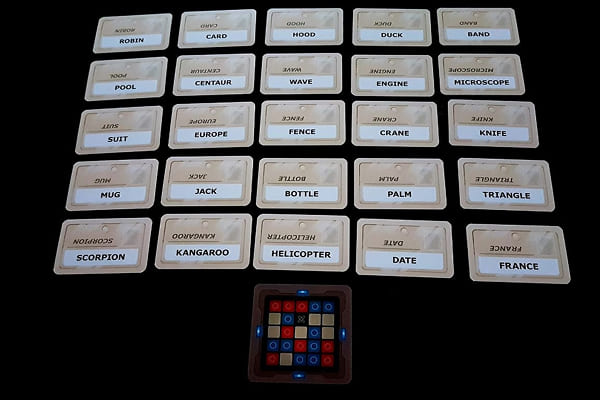Codenames

Codenames
Say one word. Make the connection. Codenames challenges your team to think fast, think wide — and think like you.
Codenames is a clever word and deduction game. Two teams compete to uncover their secret agents using clues — but say the wrong word and you might lead them to danger. It’s fast, social, and endlessly replayable.
How to Play Codenames
Each team tries to find all of their agents first — by interpreting single-word clues from their Spymaster. Here’s how it works:
- Setup: Arrange a 5x5 grid of word cards. Each word could be a red agent, blue agent, civilian, or assassin.
- Spymasters: One player from each team becomes Spymaster and sees the secret key card that shows the agent locations.
- Clues: On your turn, the Spymaster gives a one-word clue + a number (e.g., “Animal: 2”).
- Guessing: The team then guesses up to the number stated (plus one) by tapping word cards.
- Revealing: The revealed card shows whether they found their own agent, an opponent’s agent, a bystander — or the assassin (game over).
- Victory: First team to reveal all their agents wins. A wrong guess can cost your turn — or the game.
➤ Clues must relate logically — no rhymes, parts of compound words, or direct translations from foreign languages (by standard rules).
Core Mechanics
Codenames combines language, deduction, and teamwork. Here are the fundamental systems at play:
💡 Word Association
Spymasters give clues that hint at multiple words on the board — forcing clever thinking and risk-taking.
🎯 Risk Management
Guessing too many cards can backfire. Strategic players weigh safety vs. progress constantly.
🧠 Team Deduction
Players must interpret the Spymaster’s logic — often balancing literal meanings, associations, and creative leaps.
👥 Asymmetric Roles
Spymasters have full information and limited speech; their teammates have none, but make the choices. It's a trust game.
Beginner Tips
Codenames can be tricky at first — especially as a Spymaster. These tips will help both roles start strong:
- 1. Start simple.
Give clues for one or two cards only until your team gets a feel for your logic. - 2. Use categories and themes.
Think in concepts: animals, jobs, countries — not specific facts. - 3. Avoid risky overlaps.
If the assassin is near your clue, don’t go for clever. Play it safe. - 4. Guessers: talk it out.
Spymasters can’t talk — but teammates should discuss every possibility aloud. - 5. Don’t rush.
Sometimes skipping a risky guess is smarter than reaching too far.
Variants & Game Modes
Codenames is simple to expand. These modes keep it fresh, social, and accessible to different group sizes:
- 🧍 Cooperative (2–3 Players): Work together against a timer, trying to beat the board as a shared team.
- 😆 Codenames: Pictures: Use surreal art cards instead of words — visual clues, same rules.
- 🔀 House Rules: Allow two-word clues, inside jokes, or themes (movies, sports) for party games.
- 🎭 Hidden Roles (Advanced): Add a neutral “traitor” who tries to subtly mislead one team.
- 🌍 Codenames: Duet: A cooperative version designed specifically for 2 players.
➤ Many official versions of Codenames exist — including Disney, Marvel, Deep Undercover, and more. Stick to the core or find one that fits your group!